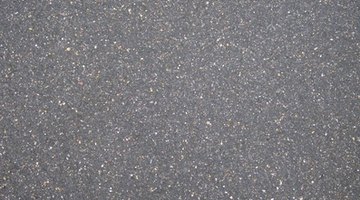How to Sponge-Paint a Concrete Floor
Any drab gray concrete floor can take on an attractive new look with a faux-finishing paint technique called “sponging.” Sponging a concrete floor takes a little preparation and more manual labor than simply painting the floor.

But the effects it produces--such as a faux marble or faux slate look--are worth the extra effort.
Things You Will Need
- Painter's masking tape
- Mop
- Porch and floor paint (4 colors)
- Paintbrushes
- Roller applicator
- 5 roller trays
- Large piece of cardboard
- 2 roller covers
- 3 or 4 natural sea sponges
- Water-based clear floor sealant
Tip
Start at the far corner of the room, farthest from the door, and work backward, back toward the door. Don't paint yourself "into a corner" so that you must walk on the wet paint to get to another section of floor. Wear kneepads for the most comfort as you kneel and slide across the floor. Latex gloves are a good idea if you are fussy about your fingernails. Your hands will be coated with paint by the end of the project and latex paint can be hard to remove from crevices around the nails.
-
Remove all the furniture from the room.
-
Mask all baseboards with a quality painter’s masking tape.
-
Mop the floor to remove surface dirt or grime from the concrete. Let the floor dry completely.
-
Paint the floor with latex floor paint made for application on concrete surfaces. Exterior porch and floor paints are best. Choose a “base” color that will form the background for your sponged floor. If, for example, you want to mimic the look of a green marble floor, base-paint the floor in a light, mossy green. Use a brush to “cut” out around the perimeter of the floor and then use a roller applicator with an extension handle to paint the rest of the floor. Let dry overnight.
-
Pour a little of each of three more paint colors into three paint trays. The best roller trays for sponging are slightly slanted and have a raised textured “deck” built into the tray. You should be able to dip the sponge in the paint and then dab the paint off the sponge a little on this textured deck.
-
Prepare your three large natural sponges for painting. Each sponge should fit comfortably in your hand. Don't cut these sponges in half to form more sponges: the cut edges will look unnatural. Wet the sponges thoroughly and wring them out aggressively to get all the water out.
-
Place the three paint trays on a length of cardboard, like a sled, so you can move all three trays at one time easily.
-
Sponge the floor with the darkest of the colors. Dip a sponge into the paint and dab any excess paint off the sponge. Lightly sponge or “tap” the sponge on the floor in a fan-like pattern in front of you. Work over just the area within your immediate vicinity instead of trying to sponge large areas at once. Rotate the sponge in your hand as you work to vary the pattern. Don’t press too hard. You want the texture of the sponge to be apparent. Pressing too hard on the sponge will form a solid block of color. Some of the base paint should show through.
-
Sponge another color over the same area. If this color and the previous color softly blend or run together a little, that’s fine. Dab with the sponge instead of "washing" the color on.
-
Dab with the lightest color over the same area. Rotate your sponge frequently or change your hand orientation or rhythm to achieve a varying pattern on the floor.
-
Sponge-paint the entire floor in this manner, working small section by small section. If you need to “start over” because the sponging effect is too blotchy, you can “reset” by painting over that section with the original base paint, using a brush or a fourth sponge. Let the floor dry.
-
Seal the floor with a water-based clear floor sealant applied with a brush and roller. Let the first coat dry overnight and then apply a second coat for further protection against water damage and abrasions.
The Drip Cap
- Any drab gray concrete floor can take on an attractive new look with a faux-finishing paint technique called “sponging.” Sponging a concrete floor takes a little preparation and more manual labor than simply painting the floor.
- Remove all the furniture from the room.
- Use a brush to “cut” out around the perimeter of the floor and then use a roller applicator with an extension handle to paint the rest of the floor.
- Rotate the sponge in your hand as you work to vary the pattern.
- Pressing too hard on the sponge will form a solid block of color.
- Sponge another color over the same area.
- Seal the floor with a water-based clear floor sealant applied with a brush and roller.
References
- "Faux Finish Secrets"; Brian Santos; 2006
- "It's Faux Easy;; Gary Lord; 2004
- "The Paint Effects Bible;" Kerry Skinner; 2003
Resources
Writer Bio
A writer and entrepreneur for over 40 years, J.E. Myers has a broad and eclectic range of expertise in personal computer maintenance and design, home improvement and design, and visual and performing arts. Myers is a self-taught computer expert and owned a computer sales and service company for five years. She currently serves as Director of Elections for McLean County, Illinois government.
Photo Credits
- Goudron image by Loïc Francois from Fotolia.com
- Goudron image by Loïc Francois from Fotolia.com
More Articles



